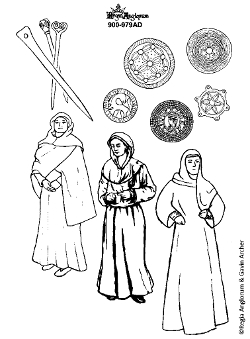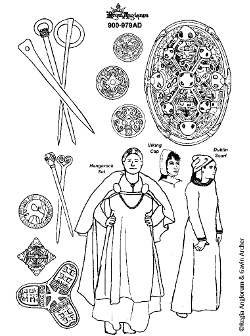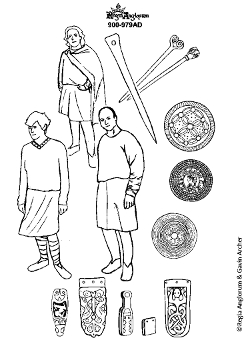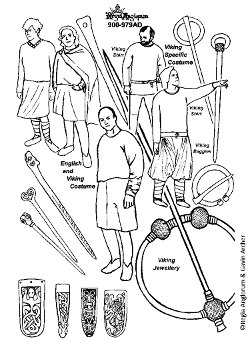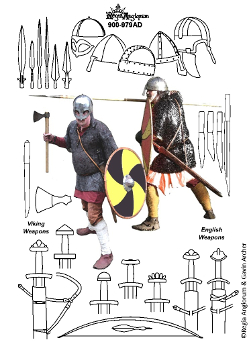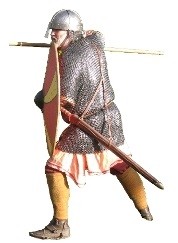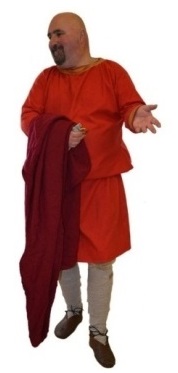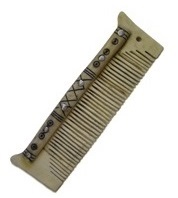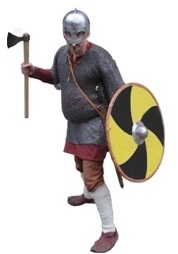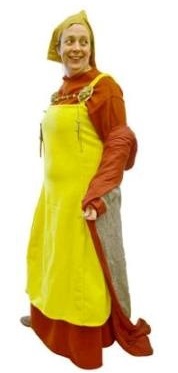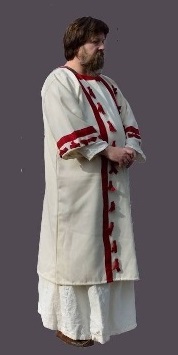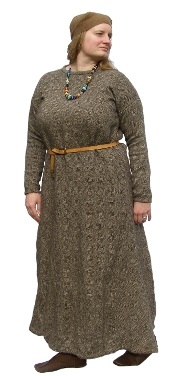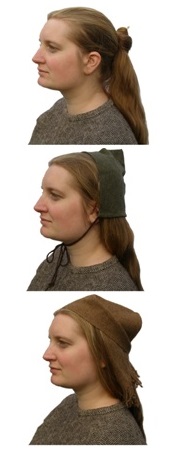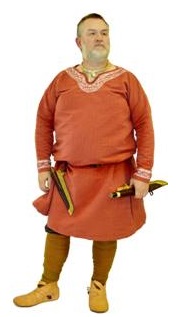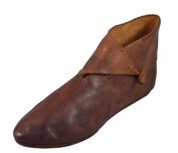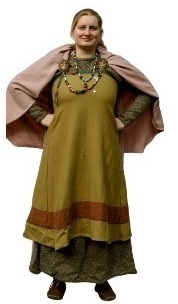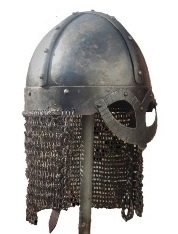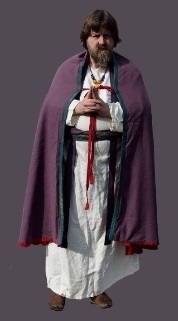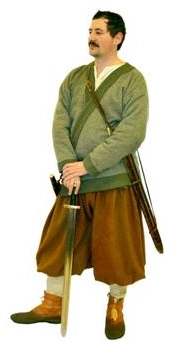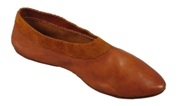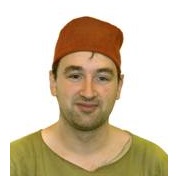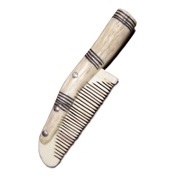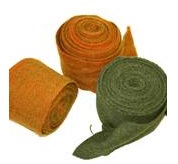Authenticity Officer’s Photo Guide – Examples of Authentic Kit
The Examples of Authentic Kit is a gallery of good examples of authentic kit, and can be used by members as a guide for what to aspire to. However, it is also an open competition amongst the membership, where they can submit photographs of themselves in kit – with examples of the most authentic kit being shown here.
All Periods
All Periods793 - 899
793 - 899900 - 979
900 - 979980 - 1041
980 - 10411042 - 1079
1042 - 10791080 - 1179
1080 - 11791180 - 1215
1180 - 1215England united under Wessex.
The traditional long scarf veil is worn by Christian women, both in England and across Europe. It is worn loosely draped over the head and wrapped around the shoulders whilst leaving the neck showing. Equally popular in England is the more hood like wimple.
The dresses are ankle length and with either tight sleeves to the wrist or else, with sleeves that are loose and cut slightly shorter to expose the cuff of the shift underneath. Neck-holes are either round or oval, and can have a keyhole opening. Decoration, in the form of facings, embroidery or tablet weave, can be applied to the cuffs. Tied belts of simple braid or cloth can be worn, but never belts of leather.
For warmth a cloak can be worn, clasped at the chest by a large disc brooch of silver or copper alloy. Poorer women would close their cloak with ties or a pin of bone, iron or copper alloy.
Shoes are of the simple, two-part turn shoe construction and are usually low, coming to below the ankle.
Jewellery is often of copper-alloy although silver and gilt brooches are worn by those that can afford them. The Winchester style is common with the Viking introduced Borre and Jelling styles used in some parts of the country.
Most Vikings are now third or more generation settlers and are Christian. They still retain their strong ties to Denmark and Norway and could best be described as being 'Anglo-Danes' or ‘Hiberno-Norse’. These Anglicised Viking women generally dress just like English women, but with their jewellery reflecting Viking art styles.
Following Christian doctrine they cover their hair just like the English. They seem to have a fashion of wearing a small head scarf or simple small cap instead of the larger veil or wimple worn by English women.
The dresses are simple, ankle length and with tight sleeves to the wrist. Neck-holes are either round or oval, and can have a keyhole opening. Decoration, in the form of facings, embroidery or tablet weave, can be applied to the cuffs and neck-hole. Tied belts of simple braid, can be worn. Leather belts are not worn by Viking women except by some Hiberno-Norse who wore a very specific style of belt fittings.
For warmth a cloak can be worn, clasped at the chest by a large disc brooch of silver or copper alloy as the trefoil brooch is falling out of fashion. The Irish influenced ringed pins are worn in the north of England and Scotland. Poorer women would close their cloak with ties or a pin of bone, iron or copper alloy.
Shoes are of the simple, two-part turn shoe construction and are usually low, coming to below the ankle. Some rich Viking women may have worn low leather boots following the Carolingian fashion.
Pagan first generation settlers and pagan Viking visitors can still be seen wearing traditional female Viking costume like that of the 9th century, although this becomes less common as the period progresses, as even in Denmark and Norway there is a growing number of Christian converts.
The primary garment is the tunic. Its skirt comes to the knee cap or just above and it’s always worn tight to the forearm and wrist. Neck-holes are either round, oval or v-shaped, and can have a keyhole opening. Decoration, in the form of facings, embroidery or tablet weave, can be applied to the cuffs and neck-hole but not around the hem of the skirt. Tunics are usually made from wool but can also be from linen.
Belts can be made from either braided wool or from a leather strap. They can be simply tied or else closed by a buckle of bone, iron or copper-alloy. Belts often have strap-ends attached.
For warmth a cloak can be worn, clasped on the right-hand shoulder by ties or a large disc brooch or pin.
Leg coverings, if worn at all, should be tight to the leg and can be hose and braies or trousers. Leg wraps can also be worn. These are long strips of 10cm wide woollen cloth worn wound about the lower leg from the ankle to the knee.
Shoes are of the simple, two-part turn shoe construction and are usually low, coming to below the ankle.
Jewellery is often of copper-alloy although silver and gilt brooches are worn by those that can afford them. The Winchester style is common with the Viking introduced Borre and Jelling styles used in some parts of the country.
Viking men’s fashion of the 10th century varies little from that of the English and does not change as dramatically as it does for women. Viking men from England are quick to adopt more Christian fashions such as disc brooches and hose and braies.
The main item of clothing is the knee length tunic and other than decorative fashion and jewellery it would be hard to tell a Viking from an Englishman. Neck-holes are either round, oval or v-shaped, and can have a keyhole opening. Decoration usually in the form of facings, embroidery and tablet weave can be applied to the cuffs and around the neck-hole.
Belts can be made from either braided wool or from a leather strap. They can be simply tied or else closed by a buckle of bone, iron or copper-alloy. Belts often have strap-ends attached.
For warmth a cloak can be worn, clasped on the right-hand shoulder by ties or a large pin or penannular. Some Anglo-Danes may wear disc brooches like the English.
Leg coverings, if worn at all, are usually trousers, but hose and braies are being adopted, even in the Viking homelands. Leg bindings can also be worn. These are long strips of 10cm wide woollen cloth worn wound about the lower leg from the ankle to the knee.
Pagan first generation settlers and pagan Viking visitors can still be seen wearing traditional male Viking costume like that of the 9th century, although this becomes less common as the period progresses, as even in Denmark and Norway there is a growing number of Christian converts.
Men tend to wear little artistic jewellery, instead mainly wearing simple decorated pins or penannulars. Ring money is worn in the shape of twisted silver neck torcs and arm rings. Some imported jewellery styles have however been adopted such as the Irish style silver Thistle brooches and some Anglo-Danes are now wearing the English style disk brooch.
Following Alfred’s reforms, the warriors of the 10th century are increasingly better equipped. Many warriors wear either the old fashioned iron domed helmet or the new style iron conical helm. A large wooden round shield is the primary form of defence, faced in leather or cloth and with an iron boss covering the centre grip. Mail shirts are usually only available to rich aristocrats and professional warriors, although they are becoming ever more common as the century progresses
Warriors carry into battle 1 or 2 javelins to throw and a spear to use one-handed and overarm in combat. Additional weapons could include a seax, a large single edged knife; a hand axe, with or without a beard; a langseax, a 45-60cm long single edged knife; or if they are very lucky, a sword. Swords are incredibly expensive and normally only carried by the rich aristocratic warrior class. The seax was carried by the English, both as a status symbol and as a weapon of last resort.
With the increased number of mail-shirts comes the bodkin arrow head. These are specifically designed to pierce armour and become common after AD950.
Warriors fight on foot and as one unit. Combat starts with exchanges of arrows, javelins and clubs. There are no specific units of 'Archers'. The two shield walls would then advance and engage with spear and sword. Many spears carry pennons and each lord would have with him a banner-man to carry his personal standard.
An aristocratic warrior with a domed helmet, lenticular round shield and mail shirt. He fights with a spear and carries an English sword on a baldric.
TedThis war knife has been blunted to make it safe for re-enactment combat.
by Ted JonesThis Lord wears a madder dyed tunic and cloak. The neck and cuffs of his tunic are decorated in tablet weave and his cloak is closed with a large disc brooch.
PatCommonly used in all of Northern Europe. Made of Red deer antler and fixed with iron rivets.
by Gavin ArcherHe wears a Viking spectacle helm and mail armour. He fights with an axe and carries an tri-lobe sword on a baldric.
GavA hangerock is worn over a madder dyed dress. A small knife is suspended from an oval brooch. For warmth she has a long coat, closed by a single trefoil brooch.
HelenRobed for Mass, in alb, stole (over right shoulder) and dalmatic. The tassels on the dalmatic go out of fashion at the end of the C10th.
MartinThis look could be seen around the Irish sea region and the Hebrides. It is an amalgamation of Viking and Irish tastes. Hiberno-Norse are the only women known to wear belts with metal fittings, of a particular style, in this period.
LouiseViking women either go bare haired or alternatively wear a simple cap (from York, Lincoln and Dublin) or a scarf (from Dublin).
by Louise ArcherHis madder dyed tunic is embroidered in the Viking Jelling style. On his belt and in his hand are English seaxes with tooled leather sheaths.
TedSimple low ankle boots like these were common in England, Frisia and France.
by Ana DeisslerSome Viking Lords wear domed helmets with a spectacle shaped face guard much as they did in earlier centuries. Many of these have an attached mail aventail to protect the neck.
modified by Roland WilliamsonDressed in 'choir' robes. A stole is worn over both shoulders - in the priestly manner. The pectoral cross and ring are the marks of a bishop.
MartinSimilar to the 'pill box' hat but extending down the back of the neck and worn in Frisia.
by Liz DabornHe wears a distinctive Pagan outfit. Baggy trousers, gathered at the knee by leg bindings and a wrap around warrior coat, pinned on his right hip.
MikeSimple slip on shoes like these have been found in England, Ireland and Denmark.
by Ana DeisslerPill Box hats appear in the Late Roman period are worn right up to the mid 10th Century, especially in Frisia.
by Liz DabornUsed in England, France and Frisia. Made of Red deer antler and fixed with iron rivets.
by Gavin Archer